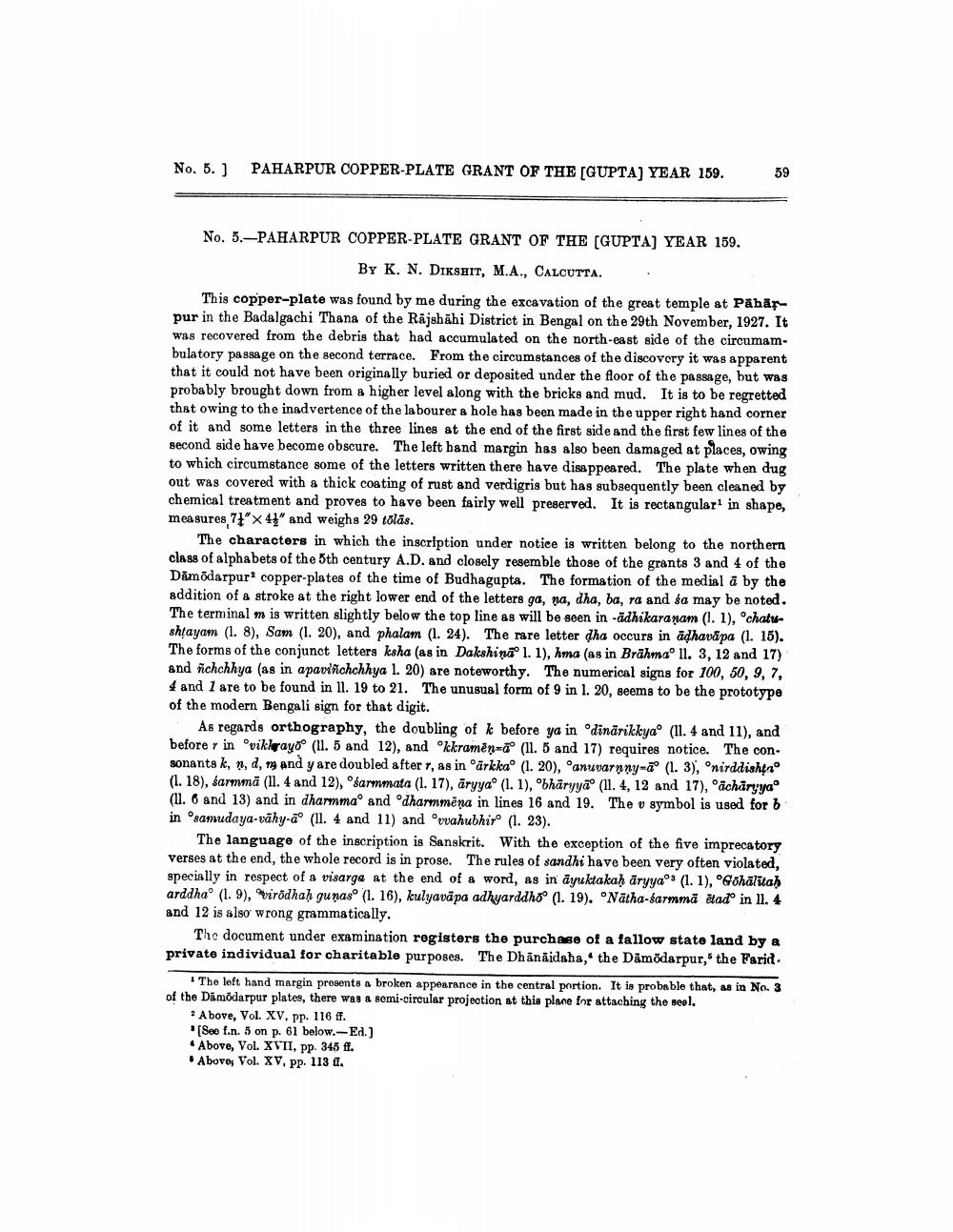________________
No. 5.)
PAHARPUR COPPER-PLATE GRANT OF THE [GUPTA) YEAR 159.
No. 5.-PAHARPUR COPPER-PLATE GRANT OF THE [GUPTA) YEAR 159.
By K. N. Diksart, M.A., CALCUTTA. This copper-plate was found by me during the excavation of the great temple at Paharpur in the Badalgachi Thana of the Rājshāhi District in Bengal on the 29th November, 1927. It was recovered from the debris that had accumulated on the north-east side of the circumambulatory passage on the second terrace. From the circumstances of the discovery it was apparent that it could not have been originally buried or deposited under the floor of the passage, but was probably brought down from a higher level along with the bricks and mud. It is to be regretted that owing to the inadvertence of the labourer a hole has been made in the upper right hand corner of it and some letters in the three lines at the end of the first side and the first few lines of the second side have become obscure. The left hand margin has also been damaged at places, owing to which circumstance some of the letters written there have disappeared. The plate when dug out was covered with a thick coating of rust and verdigris but has subsequently been cleaned by chemical treatment and proves to have been fairly well preserved. It is rectangular in shape, measures 7" x 44" and weighs 29 tolās.
The characters in which the inscription under notice is written belong to the northern class of alphabets of the 5th century A.D. and closely resemble those of the grants 3 and 4 of the Dāmõdarpur copper-plates of the time of Budhagupta. The formation of the medial à by the addition of a stroke at the right lower end of the letters ga, na, dha, ba, ra and sa may be noted. The terminal m is written slightly below the top line as will be seen in -adhikaranam (1. 1), ochatushayam (1. 8), Sam (1. 20), and phalam (1. 24). The rare letter dha occurs in ādhavāpa (1. 15). The forms of the conjunct letters ksha (as in Dakshina 1. 1), hma (as in Brāhmao 11. 3, 12 and 17) and nichchhya (as in apaviñchchhya l. 20) are noteworthy. The numerical signs for 100, 50, 9, 7, 4 and 1 are to be found in 11. 19 to 21. The unusual form of 9 in l. 20, seems to be the prototype of the modern Bengali sign for that digit.
As regards orthography, the doubling of k before ya in dinärikkyao (11. 4 and 11), and before r in Oviklarayoo (11. 5 and 12), and ®kkramēn=ão (11. 5 and 17) requires notice. The consonants k, n, d, my and y are doubled after r, as in ārkka” (1. 20), anuvarnny-a (1. 3), nirddishtro (1. 18), sarmmā (11. 4 and 12), sarmmata (1.17), aryyao (1.1), bhāryyão (11.4, 12 and 17), 'ächäryyao (II. 6 and 13) and in dharmmaand dharmmēna in lines 16 and 19. The v symbol is used for b in samudaya-vāhy-ao (11. 4 and 11) and vahubhiro (1. 23).
The language of the inscription is Sanskrit. With the exception of the five imprecatory verses at the end, the whole record is in prose. The rules of sandhi have been very often violated, specially in respect of a visarge at the end of a word, as in ayuktakaḥ äryyao: (1.1), "Göhälitah arddha' (1.9), prödhah gunaso (1. 16), kulyavāpa adhyarddhoo (1. 19). Nätha-farmmā etado in 11. 4 and 12 is also wrong grammatically.
The document under examination rogisters the purchase of a fallow state land by a private individual for charitable purposes. The Dhānäidaha,' the Dämödarpur," the Farid.
The left hand margin presents a broken appearance in the central portion. It is probable that, as in No. 3 of the Damodarpur plates, there was a semi-circular projection at this place for attaching the seel.
? A bove, Vol. XV, pp. 116 ff.
(Se f.n. 5 on p. 61 below.-Ed.) • Above, Vol. XVII, pp. 345 ff. . Aboves Vol. XV. pp. 113 ff.




